Unite the Clan - in Kyoto
The family is gone, the craziness is subsiding, the house is quiet, the weather is getting warmer, and now I can finally set myself to the task of catching up on all the pictures I've taken.
When we last spoke, our intrepid adventurers (my family) were racing across Japan at 200 miles an hour, destination: Kyoto. Four days in Tokyo had been a non-stop assault on the senses, neon lights, enormous crowds, giant department stores and what might be the most efficient train system in the world had gotten us ready for something a bit quieter, something a bit smaller - something like Kyoto.
Kyoto is a big city, don't get me wrong. About a sixth of the size of Tokyo, it is much smaller, nestled between mountains. It is one of the few cities that was never bombed during the war, so while most of the city center has been rebuilt with shopping centers, subway lines, and apartment buildings, in the cracks between the big new dirty buildings, you find old wooden houses and temples, the wood worn smooth by hundreds of years and thousands of people.
We got right to it. From the station we went to our hotel and dropped our bags, used the bathroom, and then turned right back around to go see some temples.

I can hardly remember the names of these temples. This was up a narrow wooden staircase at the top of an entryway.

Walking around in the streets in the Higashiyama area of Kyoto, every few steps you peer into a doorway or come across a garden, and the views are perfect, clean, and beautiful in a very Japanese way. Look at that tree. It couldn't be more perfect.
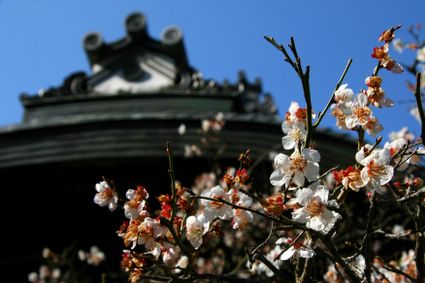
Be warned - more pictures of flowers to come.

The gardens at Ginkaku-ji.

Looking out over Ginkaku-ji. That's the center of Kyoto out there, and you may notice that there are no really tall buildings. There aren't any really giant buildings anywhere in Japan, because of the phenomenal amount of earthquakes they have here.
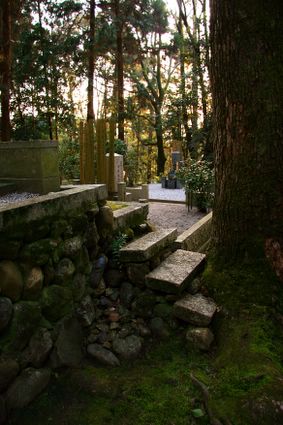
A beautiful old cemetery behind a temple, quiet and peaceful, but clean and with fresh flowers at most of the graves.

At the entrance - buckets, brooms, rags, and faucets so that you can clean your family's monument.
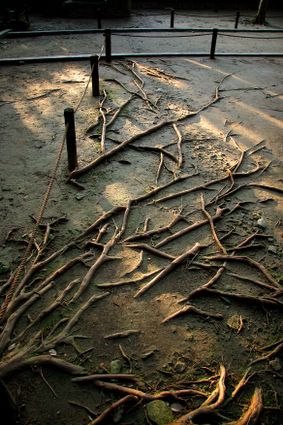
The pictures thus far have created a rosy picture - afternoon sunlight, warm weather, flowers, but they are not entirely accurate. If you were to ask my family "how was Kyoto?" The answer would most likely be "rainy." It was grey and rainy almost every day, and I took most of my pictures in brief moments of sun between long stretches of cloud. The more honest photo of Kyoto might looks more like this:

The family, hiding under some castle gateway, waiting for the latest downpour to end. We did a lot of that.
In the end though, I don't think it was much of a problem. Kyoto is a hard city to spoil, and a lot of the things we saw were really breathtaking in the rain. The old Japanese printmakers made hundreds of views of Japan in the rain, and I think they were on to something. The slate-grey roof tiles, blossoming trees, old stone walls, and grand wooden architecture was anything but diminished by the rain. If anything, the rain improved these places, making them more austere and more mysterious.
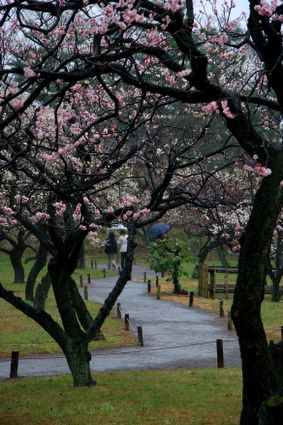

I mentioned the beautiful old things stuck in the cracks between modern buildings before. I wasn't exaggerating.

In a covered shopping street, between two little clothes boutiques, we found this little alley. Inside was a beautiful little shrine, candles burning under paper lanterns, the floors smooth and worn, a slight smell of incense and rain on old stone.

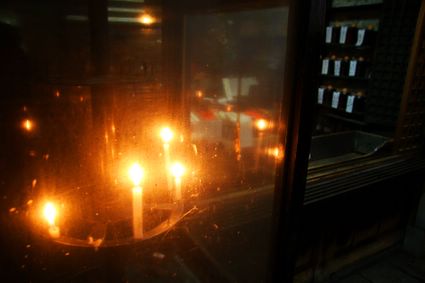
There's nothing like this anywhere near me, so it's really these little places that make Kyoto so special.
The next (cloudy) day, we headed out to Kiyomizu-dera.

In Maud's words, "there are only two kinds of temples in all of Japan - brown ones and orange ones." This is an orange one.

Again, with the weather. I am not convinced that with a blue sky this view would have been any better. It might even have been worse.

There were, of course, brief moments of sun. I made the most of them.

Gion, a historic neighborhood where geisha still work.

The gates of Chion-in. It was closed.

As the sun started going down, we took a walk around the closed temple. Coming around a corner, we found a crowd of photographers setting up tripods, a bunch of sightseers standing around and waiting, and we figured something important must be happening. We slipped in and waited. Nothing happened. We waited some more. The photographers started taking pictures, and still, there was nothing happening. Over a little time it became clear that they were not waiting for anything, but photographing a tree. One specific tree, illuminated at sundown. I don't know much about this tree, but it must be famous, and so after waiting a bit more, I took the picture everyone else was taking, and we walked on. It was a nice picture.
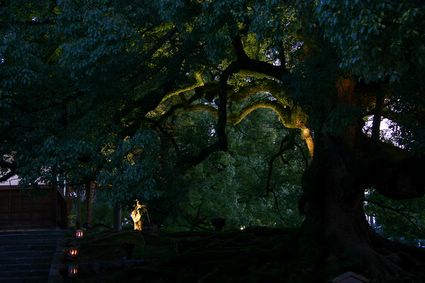

Chion-in: a couple hours later, still closed. That's the biggest front gate in all of Japan.
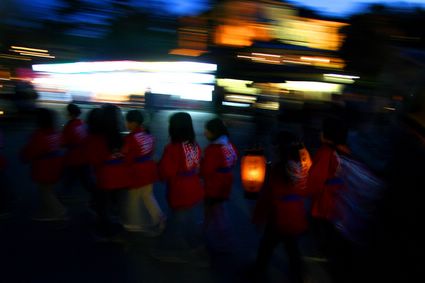
A children's festival in the street.

This temple, name long forgotten, was great at night, with hundreds of paper lanterns.


The famous and slightly silly Kinkaku-ji. This is the temple that Japanese people will always ask you if you saw.

If you ask me, the gardens behind the main building are better than the main attraction.
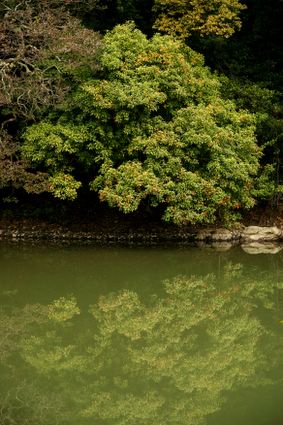

"It looks so Japanese!" Well, duh.
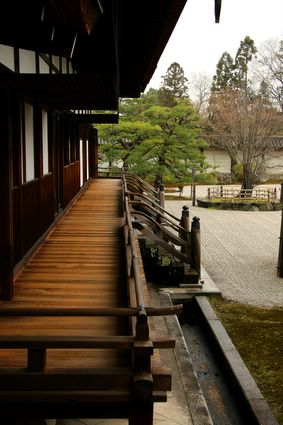
This is a different place, another perfect garden with beautiful buildings around little waterfalls, stones, gravel, and moss.


This is the winner in my flower photo competition with myself.
The afternoon of our last day in Kyoto, we went back to Chion-in before it closed. In the driving rain we made our way up the giant stone steps, following groups of Japanese tourists with their beautiful brightly colored umbrellas.

It all felt very Japanese wood block print.


Inside the main temple building.
A last story to round out the Kyoto adventure. After spending a little time in the main Chion-in building, we headed up into the cemeteries above. Long stone stairway after long stone stairway, we went up and up into the rainy mountains. The temple was about to close, so we passed a few groups of tourists going back down. At a few minutes to four, when the temple was about to close, we turned around and started walking back down. The whole way up, we had been walking near a couple of high school students, both beautiful and neither seeming particularly interested in the temples and cemeteries around them. As we turned around and started walking back down to the exit before it closed, I turned and saw that rather than turn around, they were holding hands and heading up into the hills. Scandalous!
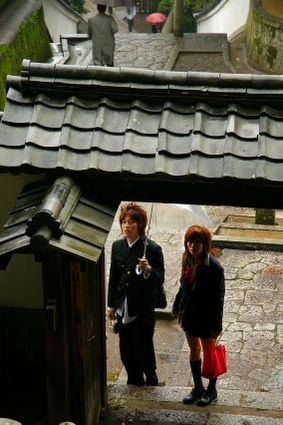
When we last spoke, our intrepid adventurers (my family) were racing across Japan at 200 miles an hour, destination: Kyoto. Four days in Tokyo had been a non-stop assault on the senses, neon lights, enormous crowds, giant department stores and what might be the most efficient train system in the world had gotten us ready for something a bit quieter, something a bit smaller - something like Kyoto.
Kyoto is a big city, don't get me wrong. About a sixth of the size of Tokyo, it is much smaller, nestled between mountains. It is one of the few cities that was never bombed during the war, so while most of the city center has been rebuilt with shopping centers, subway lines, and apartment buildings, in the cracks between the big new dirty buildings, you find old wooden houses and temples, the wood worn smooth by hundreds of years and thousands of people.
We got right to it. From the station we went to our hotel and dropped our bags, used the bathroom, and then turned right back around to go see some temples.

I can hardly remember the names of these temples. This was up a narrow wooden staircase at the top of an entryway.

Walking around in the streets in the Higashiyama area of Kyoto, every few steps you peer into a doorway or come across a garden, and the views are perfect, clean, and beautiful in a very Japanese way. Look at that tree. It couldn't be more perfect.

Be warned - more pictures of flowers to come.

The gardens at Ginkaku-ji.

Looking out over Ginkaku-ji. That's the center of Kyoto out there, and you may notice that there are no really tall buildings. There aren't any really giant buildings anywhere in Japan, because of the phenomenal amount of earthquakes they have here.

A beautiful old cemetery behind a temple, quiet and peaceful, but clean and with fresh flowers at most of the graves.

At the entrance - buckets, brooms, rags, and faucets so that you can clean your family's monument.

The pictures thus far have created a rosy picture - afternoon sunlight, warm weather, flowers, but they are not entirely accurate. If you were to ask my family "how was Kyoto?" The answer would most likely be "rainy." It was grey and rainy almost every day, and I took most of my pictures in brief moments of sun between long stretches of cloud. The more honest photo of Kyoto might looks more like this:

The family, hiding under some castle gateway, waiting for the latest downpour to end. We did a lot of that.
In the end though, I don't think it was much of a problem. Kyoto is a hard city to spoil, and a lot of the things we saw were really breathtaking in the rain. The old Japanese printmakers made hundreds of views of Japan in the rain, and I think they were on to something. The slate-grey roof tiles, blossoming trees, old stone walls, and grand wooden architecture was anything but diminished by the rain. If anything, the rain improved these places, making them more austere and more mysterious.


I mentioned the beautiful old things stuck in the cracks between modern buildings before. I wasn't exaggerating.

In a covered shopping street, between two little clothes boutiques, we found this little alley. Inside was a beautiful little shrine, candles burning under paper lanterns, the floors smooth and worn, a slight smell of incense and rain on old stone.


There's nothing like this anywhere near me, so it's really these little places that make Kyoto so special.
The next (cloudy) day, we headed out to Kiyomizu-dera.

In Maud's words, "there are only two kinds of temples in all of Japan - brown ones and orange ones." This is an orange one.

Again, with the weather. I am not convinced that with a blue sky this view would have been any better. It might even have been worse.

There were, of course, brief moments of sun. I made the most of them.

Gion, a historic neighborhood where geisha still work.

The gates of Chion-in. It was closed.

As the sun started going down, we took a walk around the closed temple. Coming around a corner, we found a crowd of photographers setting up tripods, a bunch of sightseers standing around and waiting, and we figured something important must be happening. We slipped in and waited. Nothing happened. We waited some more. The photographers started taking pictures, and still, there was nothing happening. Over a little time it became clear that they were not waiting for anything, but photographing a tree. One specific tree, illuminated at sundown. I don't know much about this tree, but it must be famous, and so after waiting a bit more, I took the picture everyone else was taking, and we walked on. It was a nice picture.


Chion-in: a couple hours later, still closed. That's the biggest front gate in all of Japan.

A children's festival in the street.

This temple, name long forgotten, was great at night, with hundreds of paper lanterns.


The famous and slightly silly Kinkaku-ji. This is the temple that Japanese people will always ask you if you saw.

If you ask me, the gardens behind the main building are better than the main attraction.


"It looks so Japanese!" Well, duh.

This is a different place, another perfect garden with beautiful buildings around little waterfalls, stones, gravel, and moss.


This is the winner in my flower photo competition with myself.
The afternoon of our last day in Kyoto, we went back to Chion-in before it closed. In the driving rain we made our way up the giant stone steps, following groups of Japanese tourists with their beautiful brightly colored umbrellas.

It all felt very Japanese wood block print.


Inside the main temple building.
A last story to round out the Kyoto adventure. After spending a little time in the main Chion-in building, we headed up into the cemeteries above. Long stone stairway after long stone stairway, we went up and up into the rainy mountains. The temple was about to close, so we passed a few groups of tourists going back down. At a few minutes to four, when the temple was about to close, we turned around and started walking back down. The whole way up, we had been walking near a couple of high school students, both beautiful and neither seeming particularly interested in the temples and cemeteries around them. As we turned around and started walking back down to the exit before it closed, I turned and saw that rather than turn around, they were holding hands and heading up into the hills. Scandalous!

posted byHi Ben. This is Heather (Hiroshima JET from Innoshima) I`ve just found your blog....your great photos filled an otherwise empty afternoon for me at the BOE. Thanks for that!
posted by
I know you're immersed in "it," but you should pick up The Artist of the Floating World by Ishiguro. Also, hope you're doing well, you sack of love.
posted by
this time through the photos i was able to hold back the tears (ganbatte me!) and they were still quite nice. although, as others may have pointed out, waaaaay japanese. *shrugs
-liz m.
posted by
I enjoy the last picture. I wish the girl was a little better lit, but i love the fact that she is looking at you while the guy is totally oblivious.
posted by
ben i really like this photo
» Post a Comment